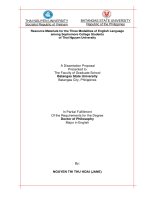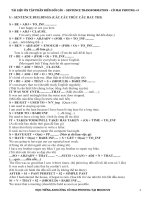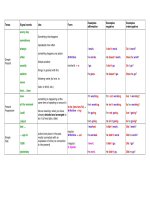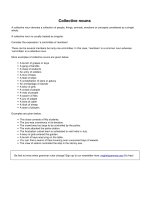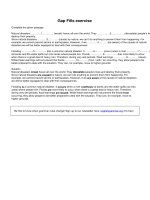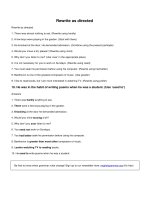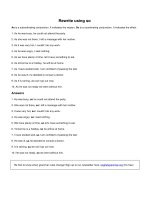Tài liệu: Identifying a verb
Bạn đang xem bản rút gọn của tài liệu. Xem và tải ngay bản đầy đủ của tài liệu tại đây (10.84 KB, 2 trang )
Identifying a verb
Words in the English language are broadly divided into eight parts of speech: nouns, pronouns, adjectives,
adverbs, verbs, prepositions, conjunctions, interjections. Words belonging to different parts of speech have
different grammatical properties. And hence students should be able to identify them.
How is identifying parts of speech done?
Well, here are some simple techniques that you can employ.
Identifying a verb
The word is probably a verb if it has different forms. For example, verbs have an –ing form and an infinitive form.
Verbs can also be used with modal auxiliary verbs like
will, shall, can, could
etc. Here are some examples:
Come
is a verb. It can be used with the modals. You can, for example, say
will come
or
should come
. It also
has an –ing form and an infinitive.
I would like to come.
I hate coming late.
Now consider the word
run
. Is it a verb? Well, let’s see. Can we use it with modal auxiliary verbs? Yes, we can.
We can, for example, say
will run
and
could run
.
He can run four miles in 30 minutes.
She will run.
The word
run
also has an –ing form and an infinitive form.
The thief tried
to run
away.
He came
running
to me.
Exercise
Underline the verbs in the following sentences.
1. My mother makes delicious cakes.
2. Alice wants to go abroad.
3. Gautam works for an insurance company.
4. The boy solved the puzzle in a few minutes.
5. The wind blew fiercely.
6. The terrorists tried to blow up the bridge.
7. The girl cried for help.
Notes
In some cases the same word can serve different purposes. For example, the word help is a verb in the sentence
‘Help me’. It is a noun in the sentence ‘She cried for help.’
Be first to know when grammar rules change! Sign up to our newsletter here: englishgrammar.org (It's free)
Powered by TCPDF (www.tcpdf.org)

